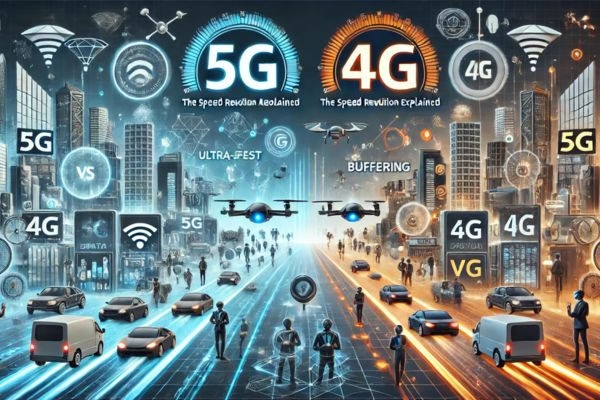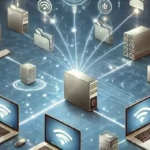As we stand on the precipice of a new era in telecommunications, the buzz around 5G technology is impossible to ignore. Promising to speed revolution the way we connect, 5G is set to surpass its predecessor, 4G, in every conceivable way. But what exactly makes 5G superior, and how will it impact our daily lives? Let’s explore the compelling advantages of 5G over 4G and why it represents the future of connectivity.
Unmatched Speed
One of the most significant advantages of 5G is its remarkable speed. While 4G networks offer download speeds of up to 100 Mbps, 5G networks can theoretically reach speed revolution of up to 10 Gbps. This exponential increase means that tasks which previously took several minutes can now be completed in mere seconds. Whether it’s downloading a high-definition movie or streaming a live sports event, the blazing speed of 5G ensures a seamless experience.
Impact on Daily Life
This boost in speed will transform everyday activities. Imagine downloading an entire season of your favorite TV show in the time it takes to make a cup of coffee. For businesses, the increased speed means reduced latency revolution and faster data transfers, enhancing productivity and enabling real-time collaboration across the globe.
Ultra-Low Latency
Latency, the time it takes for data to travel from one point to another, is a critical factor in network performance. 4G networks typically have a latency of around 50 milliseconds, which is more than sufficient for most applications. However, 5G technology reduces this to as low as 1 millisecond. This near-instantaneous data transfer opens up new possibilities for technologies that require real-time responsiveness, such as augmented reality (AR), virtual reality (VR), and autonomous vehicles.
Applications in Technology
The reduction in latency will have a profound impact on emerging technologies. For instance, in the realm of autonomous vehicles, low latency is crucial for making split-second decisions that ensure passenger safety. Similarly, in AR and VR applications, low latency will provide a more immersive and lifelike experience, paving the way for advancements in gaming, education, and remote work.
Increased Connectivity
5G is designed to connect more devices simultaneously without compromising performance. While 4G networks can support approximately 2,000 devices per square kilometer, 5G can handle up to 1 million. This capability is essential for the burgeoning Internet of Things (IoT) ecosystem, where billions of devices—from smart home appliances to wearable technology—need to communicate with one another efficiently.
Empowering the IoT
The increased device capacity will drive the proliferation of IoT solutions, leading to smarter cities, improved healthcare, and more efficient industries. Smart cities will benefit from connected infrastructure that optimizes traffic flow, reduces energy consumption, and enhances public safety. In healthcare, the ability to connect numerous medical devices will enable remote monitoring and more personalized patient care.
Enhanced Reliability and Network Slicing
Reliability is another area where 5G outshines 4G. With network slicing, 5G can create virtual networks tailored to specific applications or industries. This means that critical services, such as emergency response systems, can operate on dedicated network slices that ensure consistent performance and reliability.
Tailored Network Solutions
Network slicing allows for a more customized approach to connectivity. Industries like manufacturing, logistics, and entertainment can benefit from networks that are optimized for their unique needs. For example, a factory might require a high-reliability slice for its automation systems, while an event venue might need a high-capacity slice to accommodate thousands of simultaneous smartphone users.
Energy Efficiency
With greater efficiency in both data transmission and device connectivity, 5G is more energy-efficient than 4G. This is achieved through advanced technologies that minimize power consumption at both the network and device levels. As a result, 5G networks are more sustainable, which is crucial in the fight against climate change.
Environmental Impact
The reduction in energy consumption not only lowers operational costs for network providers but also contributes to a decrease in carbon emissions. As global awareness of environmental issues increases, the energy efficiency of 5G could play a significant role in achieving sustainability goals.
Challenges and Considerations
Despite its many advantages, the transition from 4G to 5G is not without challenges. The implementation of 5G infrastructure requires significant investment in new technologies and equipment. Additionally, concerns over privacy and security must be addressed, as the increased connectivity of 5G networks could potentially expose more data to cyber threats.
Overcoming Obstacles
To overcome these challenges, collaboration between governments, industry leaders, and technology experts is essential. Clear regulations and robust security measures must be established to ensure the safe and secure deployment of 5G networks.
Conclusion
The dawn of 5G marks a transformative period in the world of connectivity. With its unrivaled speed revolution , ultra-low latency, increased device capacity, enhanced reliability, and energy efficiency, 5G is poised to surpass 4G in every way. As we harness the full potential of 5G, we can expect to see profound changes in how we live, work, and interact with technology. The future of connectivity is here, and it promises to be faster, smarter, and more connected than ever before.


